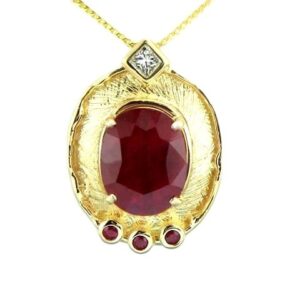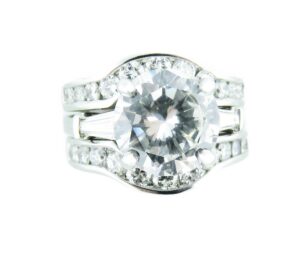Gold has been a symbol for wealth, beauty, and luxury for centuries now. It’s important to be aware of gold jewelry purity when making a decision. Gold purity is measured in karats (K), which indicate how much pure gold is in a piece of jewelry. This guide will break down the differences between 10K, 14K, 18K, and 24K gold, helping you choose the best option based on your needs and preferences.
What’s In A Karat: How Gold Purity Is Measured
When shopping for gold jewelry, you may notice different karat markings, such as 10K, 14K, 18K, and 24K. But what do these numbers mean? Gold purity is measured in karats (K), which indicate the percentage of pure gold in a piece of jewelry. A higher karat number means a higher percentage of gold.
Gold is naturally soft and is often mixed with other metals like copper, silver, and zinc to improve durability and strength. The karat system helps buyers understand how much pure gold is in their jewelry.
What is the Difference Between Karat and Carat?
Many people confuse “karat” and “carat,” but they are different terms:
- Karat (K) refers to the purity of gold.
- Carat (ct) is a unit of weight used for gemstones, such as diamonds.
For example, a 14K gold ring has 58.3% gold, while a 1-carat diamond weighs 0.2 grams.
How Is Gold Purity Measured?
Gold purity is measured using the karat system, which divides gold into 24 parts. For example:
- 24K gold is 100% pure gold (24/24 parts gold).
- 18K gold is 75% pure gold (18/24 parts gold, 25% alloy).
- 14K gold is 58.3% pure gold (14/24 parts gold, 41.7% alloy).
- 10K gold is 41.7% pure gold (10/24 parts gold, 58.3% alloy).
Many jewelers use acid tests, electronic testers, or hallmark stamps to verify gold purity.
Difference Between 10K, 14K, 18K, and 24K Gold
Each gold type has unique characteristics that affect durability, appearance, and cost.
10K Gold
- Purity: 41.7% gold, 58.3% alloy
- Pros:
- The most durable gold option
- Highly resistant to scratches and dents
- More affordable than higher-karat gold
- Ideal for everyday wear
- Cons:
- Less pure gold content results in a duller color
- May cause allergic reactions due to higher alloy content
- Not as luxurious in appearance as higher karats
- Best For: Everyday jewelry like rings, bracelets, and watches
14K Gold
- Purity: 58.3% gold, 41.7% alloy
- Pros:
- Great balance between durability and gold purity
- Richer color compared to 10K gold
- Popular choice for engagement rings and wedding bands
- More affordable than 18K and 24K gold
- Cons:
- Can still cause allergic reactions for people sensitive to alloys
- Not as rich in color as higher karats
- Best For: Engagement rings, necklaces, and everyday jewelry
18K Gold
- Purity: 75% gold, 25% alloy
- Pros:
- Rich, warm yellow color
- Higher purity means fewer alloy-related allergic reactions
- More luxurious and valuable than 10K and 14K gold
- Cons:
- Softer than 10K and 14K gold, making it prone to scratches
- More expensive due to higher gold content
- Requires more maintenance to keep its shine
- Best For: High-end jewelry, wedding bands, and fine accessories
24K Gold
- Purity: 100% pure gold
- Pros:
- The purest and most valuable form of gold
- Does not tarnish or corrode
- Hypoallergenic, making it ideal for sensitive skin
- Vibrant gold color
- Cons:
- Very soft and prone to bending or scratching easily
- Not ideal for daily wear
- The most expensive gold option
- Best For: Investment purposes, collectible items, and luxury jewelry
Read More: Gold vs. Silver? Choose the Right Jewelry Metal
Gold Karat Chart
| Karat | Gold Purity (%) | Strength | Common Uses |
| 10K | 41.7% | Very Durable | Rings, Bracelets |
| 14K | 58.3% | Durable | Engagement Rings, Necklaces |
| 18K | 75% | Softer | Luxury Jewelry, Wedding Bands |
| 24K | 100% | Very Soft | Investment, Collectibles |
Why Isn’t Pure Gold Used to Make All Jewelry?
While 24K gold is the purest form, it is too soft for daily wear. Jewelry made from 100% gold would bend or scratch easily. That’s why jewelers mix gold with stronger metals like copper or silver to increase their durability, ensuring that pieces last longer without losing their beauty.
Which Gold Type Is Right for You?
Choosing the right gold depends on:
- Budget – 10K and 14K gold are more affordable, while 18K and 24K are more expensive.
- Durability – If you want jewelry for everyday wear, 10K or 14K gold is best.
- Color Preference – Higher karat gold has a richer, deeper gold color.
- Skin Sensitivity – 18K and 24K gold have fewer alloys, making them ideal for sensitive skin.
Where Can I Buy Gold in York, PA?
Selecting the ideal gold jewelry may be difficult, but with the help of expert professionals, you can have the ideal piece that suits your requirements. If you are in York, PA, Gem Boutique is the Best Place to Sell Gold with a diverse range of 10K, 14K, 18K, and 24K gold jewelry. Our professional staff can guide you in making the best decision, so you select a piece that is appropriate for your choice and affordable price.


